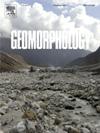Characterizing barchan dune interactions based on high-resolution remote sensing imagery
IF 3.1
2区 地球科学
Q2 GEOGRAPHY, PHYSICAL
引用次数: 0
Abstract
Variations in the migration rates of barchan dunes of different sizes make dune merging and separation a prevalent phenomenon that is essential for controlling the scale of barchan dune swarms and regulating the evolutionary patterns of dune fields. However, existing research relies predominantly on numerical simulations or flume experiments. The morphology and migration characteristics of barchan dunes at various stages of merging or separation in natural settings and their responses to wind conditions still need to be explored. To examine the types and morphological and migratory characteristics of barchan dunes across different merging and separation phases while elucidating the impacts of wind conditions, dune morphology, and relative positions of barchan dunes on these processes, we used high-resolution remote sensing images and extended time series meteorological data. The main conclusions are as follows: (1) The mering types of barchan dunes include lateral, offset, and coaxial merging. The separation types include lateral splitting, separation from the leeward slope, and separation from the horn. (2) The barchan dune migration rate at different merging or separation stages was logarithmically negatively correlated with the dune basal area. The migration distance of a barchan dune under a specific wind force can be expressed by the ratio of the resultant wind force to the dune height, and their fitting parameters differed in the process of isolation → merging → separation. (3) Under a certain wind condition, when the migration distance of the upwind barchan is greater than the sum of the migration distance of the downwind barchan and the distance between the two dunes, two adjacent isolated dunes merge. According to the height and distance of adjacent isolated dunes, the wind force required for dune merging can be judged by Eq. (6). (4) There was a power function relationship between lateral spacing factor and dune size factor and a logarithmic positive correlation between longitudinal spacing factor and dune size factor of barchans in the merging state. However, the fitting parameters changed with dune coalescence and separation, which could be used to predict whether the merging dunes would separate again.
求助全文
约1分钟内获得全文
求助全文
来源期刊

Geomorphology
地学-地球科学综合
CiteScore
8.00
自引率
10.30%
发文量
309
审稿时长
3.4 months
期刊介绍:
Our journal''s scope includes geomorphic themes of: tectonics and regional structure; glacial processes and landforms; fluvial sequences, Quaternary environmental change and dating; fluvial processes and landforms; mass movement, slopes and periglacial processes; hillslopes and soil erosion; weathering, karst and soils; aeolian processes and landforms, coastal dunes and arid environments; coastal and marine processes, estuaries and lakes; modelling, theoretical and quantitative geomorphology; DEM, GIS and remote sensing methods and applications; hazards, applied and planetary geomorphology; and volcanics.
 求助内容:
求助内容: 应助结果提醒方式:
应助结果提醒方式:


